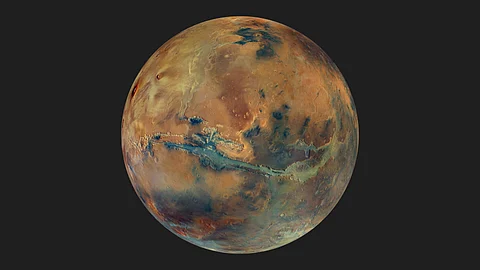

For decades, scientists have believed that the Red Planet’s distinctive hue is due to iron minerals rusting under dry conditions over billions of years. However, new research combining spacecraft data from the European Space Agency (ESA) and National Aeronautics and Space Administration (NASA) with advanced laboratory experiments suggests Mars’ rusty dust has a much wetter history than previously assumed.
A study led by Adomas Valantinas, a postdoctoral researcher at Brown University, has revealed that Mars’ red colour is best explained by ferrihydrite — a form of iron oxide that requires water to form — rather than hematite, which was long thought to be responsible for the planet’s dust.
The paper was published February 25, 2025 in the journal Nature Communications.
“We were trying to create a replica martian dust in the laboratory using different types of iron oxide. We found that ferrihydrite mixed with basalt, a volcanic rock, best fits the minerals seen by spacecraft at Mars,” Valantinas explained.
Mars may rusted much earlier in its history, during a time when liquid water was still present on its surface, the study suggested. Unlike hematite, ferrihydrite forms rapidly in cool water, meaning its presence on Mars is direct evidence of the planet’s wetter past.
“Mars is still the Red Planet. It’s just that our understanding of why Mars is red has been transformed,” Valantinas added.
Over billions of years, Mars’ rusted material has been broken down into dust and spread across the planet by powerful winds — a process that continues today. Previous research, based primarily on spacecraft data, failed to detect water in the planet’s iron oxides, leading scientists to conclude that Martian dust formed under dry conditions.
This new study, however, integrated orbital and ground-based observations with precise laboratory experiments to overturn that assumption.
To reach these conclusions, researchers recreated Martian dust in the lab by grinding minerals to a fine powder — comparable to dust particles on Mars, which are around 1/100th the width of a human hair. By using analytical techniques similar to those employed by orbiting spacecraft, they were able to match the properties of their synthetic dust to the real Martian samples.
“This study is the result of the complementary datasets from the fleet of international missions exploring Mars from orbit and at ground level,” said Colin Wilson, ESA’s project scientist for the Trace Gas Orbiter (TGO) and Mars Express missions.
ESA’s Mars Express provided crucial insights into the mineral composition of Martian dust, confirming that even the planet’s most dust-covered regions contain water-rich minerals.
Meanwhile, the TGO’s ability to observe Mars under varying illumination and angles allowed scientists to differentiate particle size from composition, helping them better replicate the dust in the lab. NASA’s Mars Reconnaissance Orbiter and the Curiosity, Pathfinder and Opportunity rovers also provided vital data to support the findings.
The presence of ferrihydrite suggested that Mars underwent a period of cold but wet conditions before transitioning into the dry and barren world we see today. Since ferrihydrite is known to trap water and protect organic molecules, its discovery raised new questions about Mars’ potential to have once supported microbial life.
Future missions, such as ESA’s Rosalind Franklin rover and the NASA-ESA Mars Sample Return mission, could further solidify these findings. Some of the dust samples already collected by NASA’s Perseverance rover are awaiting return to Earth, where they will be examined in more detail to determine how much ferrihydrite they contain.
“Once we get these precious samples into the lab, we’ll be able to measure exactly how much ferrihydrite the dust contains and what this means for our understanding of the history of water — and the possibility for life — on Mars,” Wilson said.